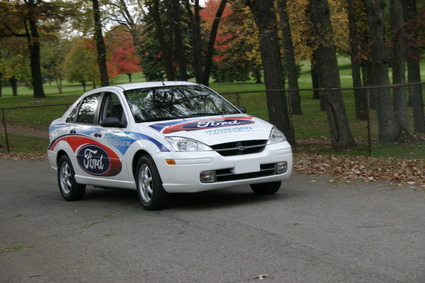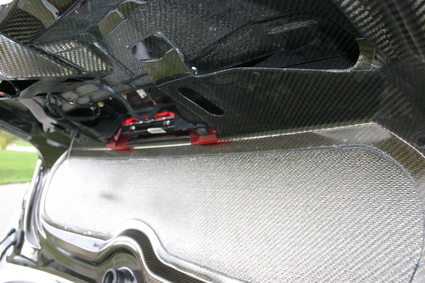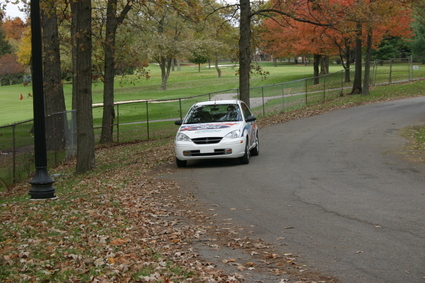Unfortunately, the Focus FCV was only in the AutoBlogGreen Garage for 24 hours, something that limited our testing opportunities. After taking my wife and son for a drive we shot some video and and a lot of photographs. I did manage to squeeze in some informal performance testing on a relatively long empty driveway. With my son operating the stopwatch in the right seat, I did some 0-30 mph and 0-50 mph runs. The torque of the electric motor provides good off the line response getting to 30 mph in an average of about 5 seconds. Getting to 50 mph took about 10 seconds.
This car is no Focus SVT but it's in the same ballpark as a base 2.0L automatic Focus. According to Ford engineer Mark Olance, the Ballard fuel cell can actually put out more power, but they limit it to provide the same overall performance as the standard Focus and also optimize the range. Speaking of range, Ford claims a range of about 175-225 miles on a tank of hydrogen. When I got the car, the gauge read a little more than 3/4 of tank, and when I returned it about 100 miles later it had a little under 1/4 tank, which, considering my acceleration runs, makes Ford's range claims plausible. Continue reading about the Focus FCV's performance after the jump.
Highway performance was also good. The car had no problem accelerating from the on-ramp into morning rush-hour traffic on I-94. Cruising along at 70-80 mph with the flow of traffic proved effortless, demonstrating again that this is a completely viable day-to-day car.

The handling of the Focus was also quite good considering the extra weight it was carrying. The FCV is about 900 lbs porkier than a regular Focus, due to all the extra hardware for the hydrogen storage, battery, fuel cell and powertrain. Fortunately, the bulk of that extra hardware, except for the hydrogen tank, sits low in the car, keeping the center of gravity low. This allows for relatively flat cornering especially given the upright stance of the Focus. There are definite signs of weight saving efforts by Ford. On the inside of the trunk lid, the steel that would normally provide the supporting structure has been replaced by carbon fiber. This was the only visible sign, but there are probably others.

Another advanced feature of the Focus FCV is the electro-hydraulic brake (EHB) system. When the driver applies the brake pedal, a travel sensor measures the distance and apply rate and then generates the brake pressure that is applied to each individual wheel. Although, Mercedes used a similar system on several of their current production models in recent years, they have abandoned it because conventional systems can match the performance at much less cost. Electric and hybrid cars however, need to use such systems in order to accommodate regenerative braking. Regen braking uses the vehicle decel to drive the motor as a generator that charges the battery. All electric cars like the Focus need to use such systems as well to provide brake boost since they have no vacuum source from an engine.

The brake system of the Focus includes anti-lock brake functionality and provides excellent pedal feel in the limited driving that was available. There is no mushiness, and more importantly, the behavior is very consistent. One criticism of previous EHB systems has been inconsistent behavior when applying the brakes. The Focus displayed a smooth, linear response to pedal applies and good modulation. A handful of hard applies also demonstrated smooth, straight stops with no jerking of the steering wheel. Speaking of the steering, it was also responsive and showed no slop. It's not a BMW, but it's quite acceptable.




Sign in to post
Please sign in to leave a comment.
Continue